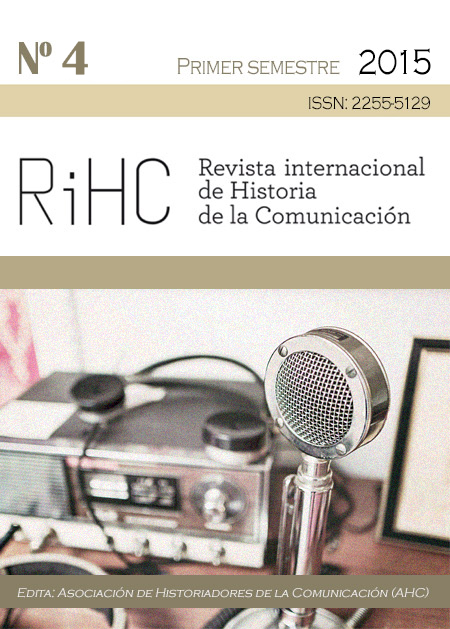La prensa filipina en español entre dos guerras (1899-1941)
DOI:
https://doi.org/10.12795/RiHC.2015.i04.02Keywords:
Prensa, Filipinas, español, nacionalismoAbstract
La derrota española en la guerra con Estados Unidos en 1898 no supone la extinción de la prensa en español en Filipinas. Aunque 1899 abre una nueva y muy distinta etapa en las islas, el español sigue siendo idioma oficial y en español se editarán múltiples periódicos de muy distintas orientaciones, incluida una prensa nacionalista contraria a la ocupación norteamericana y desde luego la prensa católica. Pero la introducción del inglés en la escuela, desplazando al español, supone que al cabo de dos generaciones se produzca una inversión de la situación, pasando el español, que ha sido también el idioma mayoritario en la literatura filipina, a un papel crecientemente secundario. En ese panorama, cuando también la prensa en idiomas locales se expande y se multiplican los periódicos bilingües o trilingües, la invasión de las islas por Japón en 1941 crea una nueva situación de la que el gran perjudicado será el periodismo en español. Este artículo describe y analiza todo ese proceso.
Downloads
References
ARTIGAS CUERVA, Manuel (1909), Los periódicos filipinos: la más completa bibliografía publicada hasta la fecha acerca de los papeles públicos filipinos, Biblioteca Nacional Filipina, Manila, 224 pp. [Disponible, incompleto, en http://hdl.handle.net/2027/miun.arb8044.0001.001]
CAILLES UNSON, Ben (19699, «La literatura hispanofilipina», en Archivum, tomo 19, pp. 275-291,
CANO, Gloria (2011), «Filipino Press between Two Empires: El Renacimiento», en Southeast Asian Studies, Vol. 49, No. 3, pp.! 395-430.
COLET VALLADOLID, Alice (2006), «Featuring-- the Philippine press, 1637-2005», Pasig, Manila, 122pp.
LENT, John A. (1970), «Guerrilla press of the Philippines, 1941-1945» en Asian Studies, volume 8-2, pp. 260-174
PALMA, Rafael (1914), Voces de Aliento. Colección de artículos literarios, Imprenta Cultura Filipina, Manila, 217 pp. [Disponible en www.cervantesvirtual.com]
REYES ENCANTO, Georgina (2004), Constructing the Filipina: a history of women's magazines, 1891-2002, University of the Philippines Press, Quezon City, 121 pp.
RODAO, Florentino (2011), «De colonizadores a residentes. Los españoles ante la transición imperial en Filipinas», en Elizalde, María Dolores, y Delgado, Josep María, editores, Filipinas, un país entre dos imperios, UAB, Bellaterra, pp. 251- 297.
RODAO, Florentino (2012), «El español durante la guerra civil: las revistas ideologizadas», en Donoso Jiménez, Isaac, editor, Historia cultural de la lengua española en Filipinas. Ayer y hoy, Verbum editorial, Madrid, pp. 459-510.
ROPERO, Godofredo (2008), «Cebu media history: evolving through 100 years 1905-2005», en Philippine Conmunication Centrum, Manila. [Disponible en ww2.aijc.com.ph/OCCF/mediamuseum/timeline/timeline@cebu.htm]
ROSARIO-BRAID, Florangel, y Tuazón, Ramon R. (1999), «Communication Media in the Philippines: 1521-1986»,en Philippine Studies vol. 47, no. 3, pp. 291-318.
SORIANO, D.H. (1987), The Roces family: publishers, with as History of the Philippine Press, Islas Filipinas Pub., Manila, 146 pp.
TAYLOR, Carson (1927), History of the Philippine Press, s/e, Manila, 1927, 62 pp.
www.archive.org [colecciones de revistas como Cultura Social o Revista Filipina]
www.cervantesvirtual.com [textos sobre Filipinas]
www.hemerotecadigital.bne.es [colecciones de periódicos como La redención del obrero o Voz española]
Philippine Communication Centrum: http://aijc.com.ph
American newspaper annual and directory, Ayer and son’s, Filadelfia, 1903/1922.
Rizal Library/Ateneo de Manila: http://rizal.lib.admu.edu.ph
Downloads
Published
How to Cite
Issue
Section
License
RiHC. Revista internacional de Historia de la Comunicación is an open access publication, offering its content under the principle that making research available to the public free of charge contributes to the greater exchange of global knowledge.
RiHC. Revista internacional de Historia de la Comunicación adheres to the various initiatives that promote access to knowledge. All content is therefore free of charge and is published under the Creative Commons Attribution-NonCommercial-ShareAlike 4.0 International license.
By virtue of this, the authors who publish in this journal accept the following conditions:
- Open access content may be freely shared (that is, copied and redistributed in any medium or format) and adapted (remixed, transformed and built upon).
- Attribution: The user of the content must give appropriate credit, provide a link to the license, and indicate if changes were made. This may be done in any reasonable manner, but not in any way that suggests the licensor endorses the user or their use.
- Non Commercial: The content may not be used for any commercial purpose.
- Share Alike: If the content is remixed, transformed or built upon, it must be distributed under the same licence as the original.
- No additional restrictions: No legal terms or technological measures may be applied that legally restrict others from doing anything the licence permits.













